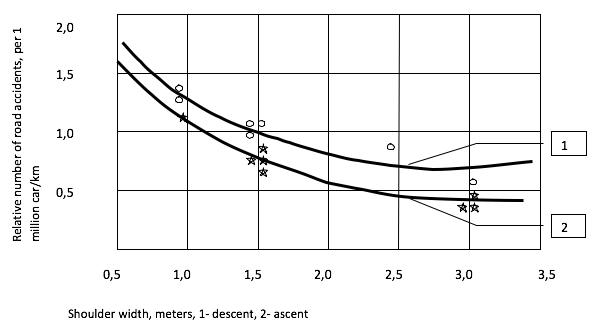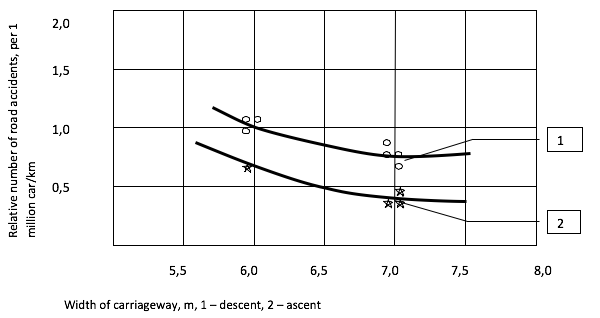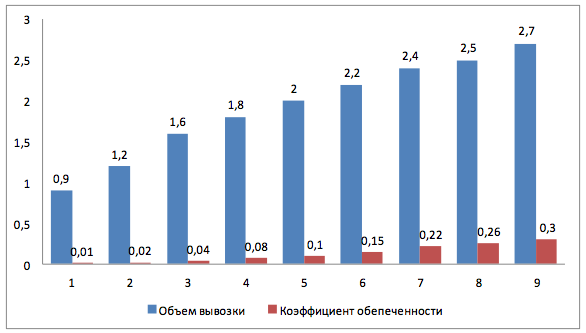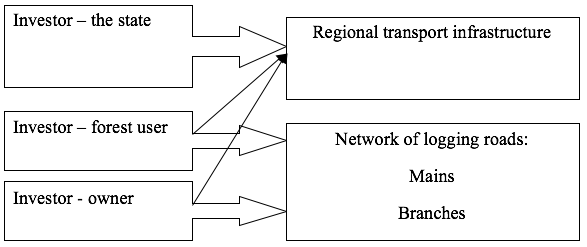

 Vol. 39 (Number 12) Year 2018. Páge 5
Vol. 39 (Number 12) Year 2018. Páge 5
V.A. MORKOVIN 1; S.I. SUSHKOV 2
Received: 01/11/2017 • Approved: 20/11/2017
ABSTRACT: The authors study the state and the level of development of forest transport infrastructure in the Russian Federation. The influence of logging roads on the natural environment and the number of road accidents is analyzes. The character of the influence of logging roads on the natural environment and the number of road accidents depends on the peculiarities of forest concessions and geographical conditions. It is established that complex landscape leads to reduction of the relative indicators of accidents rate. Direct dependence between the volumes of logging and car transport provision of forest areas is shown. Creation of logging roads requires large investments – at that, the investors could be not only forest users but also the state and owners of forests. Development of the forest transport infrastructure requires application of tariff regulation, ensuring growth of the cost of resources; increase of the level of acquisition of forest concessions by lessor (at the level of district and region); provision of the access to credit resources for construction of forest roads with low interest rate. |
RESUMEN: Los autores estudian el estado y el nivel de desarrollo de la infraestructura de transporte forestal en la Federación de Rusia. Se analiza la influencia de la tala de caminos en el entorno natural y el número de accidentes de tráfico. El carácter de la influencia de la tala de caminos en el medio ambiente natural y el número de accidentes de tránsito depende de las peculiaridades de las concesiones forestales y las condiciones geográficas. Se establece que el paisaje complejo conduce a la reducción de los indicadores relativos de la tasa de accidentes. Se muestra la dependencia directa entre los volúmenes de tala y la provisión de transporte de áreas boscosas. La creación de rutas forestales requiere grandes inversiones; en ese sentido, los inversores podrían ser no solo usuarios del bosque, sino también el estado y los propietarios de los bosques. El desarrollo de la infraestructura de transporte forestal requiere la aplicación de una regulación tarifaria que asegure el crecimiento del costo de los recursos; aumento del nivel de adquisición de concesiones forestales por parte del arrendador (a nivel de distrito y región); provisión del acceso a recursos de crédito para la construcción de caminos forestales con baja tasa de interés. |
Scientific studies and the world practice show that forest resources become accessible and forest economy becomes successful if the density of road network in a forest areas is at least 10 route meters per 1 hectare of forest area. This means that in each forest quarter sized 1000×1000 m, a forest road 1 km long is to be constructed.
It should be noted that in most forest regions of the RF, average density of road network is fat from the above indicators and constitutes only 0.15 route meters per 1 hectare. One of the most important components of forest infrastructure is forest transport infrastructure (Morkovina, 2015).
It is a network of transport roads that connect logging operators with final consumers of forest products. This infrastructure is used during execution of works on forest restoration and forest care and ensures the possibilities for fighting forest fires. The level of development of forest transport infrastructure determines the state and perspectives of development of the whole forest-industry complex (Sushkov, 2016). For Russia, the state of forest transport infrastructure is a decisive factor of development of forest sphere and its competitiveness in the global commodity markets. The state and the level of development of forest transport infrastructure in the Russian Federation are different depending on the region (Morkovina, 2014).
In Russia, the lack of logging roads is observed in the regions with the largest forest resources: North-Western, Ural, Siberian, and Far Eastern Federal Districts. There, the density of forest roads per 1,000 hectares of forest area constitutes 2.4 in the North-West of Russia to 0.4 km in the Far East. In these conditions, the task of development of forest transport infrastructure for involvement of new forest territories into economic turnover on the basis of economically substantiated principles of design and construction of logging car roads becomes topical.
The objects of studying the influence of logging car roads on natural environment and number of road accidents are two-lane roads with improved light cover. The intensity of movement on the studied roads did not exceed 2,300 cars per day.
In order to solve the set task – determining quantitative and qualitative characteristics of the influence of road and shoulder width on the road accident rate on the studied logging car roads – the areas with similar road conditions were distinguished. The length of these areas constituted 2 – 15 km.
In order to evaluate the effectiveness of construction of logging car roads, the coefficient of economic motor transport provision of forest resources of the regions was calculated. Calculation of the coefficient of economic motor transport provision of forest resources of the region is conducted by the following formula:

Forest roads are one of the most important components of forest industry infrastructure and perform several functions. одновременно. Road branches belong to technological roads which are aimed for the purposes of procurement and removal of timber, as well as for provision of the possibility of works on forest restoration and forest care. As of now, more than 195 m³ of timber cannot be procured in Russia due to lack of transport access. The length of forest roads in the Russian Federation constitutes 1.2 km per 1,000 hectares of forest area, while in Western countries this value equals 9–40 km (Figure 1).
Figure 1
Transport infrastructure of the forest complex of the
Russian Federation and some foreign countries

In order to put this resource into the turnover and to increase the intensity of forests use, it is necessary to construct around 1,100 km of forest roads. For each kilometer of forest road involves 1,000 hectares of forest into turnover and ensures the removal of 1,000 – 2,000 m3 of timber. In the world practice, 1 km of new road costs €30,000, i.e., RUB 1.4 million.
In order to provide the necessary rates of development of forest complex, it is necessary to invest RUB 8 billion annually.
At present, in the total length of car roads and railroads, the former account for 39,427 km, or 92%, while the latter – only 3,350 km (8%).
Relative length of car roads with hard cover constitutes 27%. At that, for general use roads this indicator constitutes 88%, while for logging roads — only 10%.
Insufficient density and low capacity of forest roads make logging operators perform timber removal along the general use roads, aggravating their unsatisfactory condition (Sushkov, 2005). The character of influence of logging car roads on natural environment and the number of road accidents depends on peculiarities of forest concessions and geographical conditions. Transport and economic connections in the companies of the forest complex are conducted with log trucks (99.5%) and with the general use transport (0.5%), while the leading role belongs to car transport (Kuznetsov, 2013). The network of logging car roads has a clear hierarchical structure. It is based on a large group of primary forest transport roads (strip roads, cleared stripes, and spur tracks) and collecting mains.
Analysis of road accidents and road conditions on two-lane car roads, located in the low-mountain and mid-mountain areas (elevation 300-1500 m) allowed for evaluation of the level of danger of passage depending on the complexity of local topography. The results of the analysis showed that complication of the local topography leads to reduction of the indicators of accidents rate (Table 1).
Table 1
Dependence of the level of danger of passage on the local topography
Indicators of danger of passage per 1 million cars/km |
Category of complexity of local topography |
||
2 |
3 |
4 |
|
Relative accident rate |
0.71 |
0.62 |
0.40 |
wounded |
0.52 |
0.63 |
0.31 |
killed |
0.30 |
0.22 |
0.12 |
Road accident statistics on logging car roads of the RF confirmed the hypothesis and allowed determining that the relative number of people hurt in the accidents in mountainous area is by 1.25 higher than in flat area.
The latter circumstance requires thorough study of the regularities of movement of car transport along mountainous roads and consideration of the determined peculiarities in the norms of design of mountain roads and organization of safe exploitation of roads in mountainous areas.
The joint analysis of statistics of road accidents over recent five years and studies of geometric elements of logging car roads allowed for determination of the influence of the width of carriageway and shoulder on relative accident rate and for results of the accident rate coefficients which characterize these elements of logging car roads’ cross profile from the point of view of their influence on relative danger of passage.
Analysis of distribution of the number of accidents allowed obtaining the coefficient of dependence of relative accident rate on the width of carriageway and shoulder (Figures 2 and 3).
Figure 2
Dependence of the relative number of road accidents on shoulder width

As is seen from the graph, with constant carriageway width, reduction of the relative number of road accidents per 1 million car/km is observed. Such character of change of relative road accident rate is observed with the values of shoulder width that are equal to 2.5-3 m. Further growth of shoulder width does not substantially influence the value of relative number of road accidents on logging car roads (Sushkov, 2015).
At that, for larger width of carriageway, reduction of accident rate is more intensive.
Such character of received dependence allows for the conclusion that as to logging car roads the optimal – from the position of provision of least accident rate shoulder width is 2.5-3 m.
Technical and economic comparison of the variants of projects and evaluation of transport and exploitation indicators of existing roads with the use of the above method of accident rate coefficients, offered by V.F. Babkov (Babkov, 1980), allows recommending the following indicators of accident rate (Table 2).
Table 2
Value of accident rate coefficients for assessment of influence of shoulder
width with various widths of carriageway of logging car roads
Shoulder width, m |
1 |
1 |
1.5 |
2.0 |
2.5 |
3.0 |
|
Accident rate coefficient with the shoulder width |
6 m |
5.0 |
3.7 |
3.0 |
2.5 |
2.2 |
2.0 |
7 m |
4.9 |
3.1 |
2.3 |
1.7 |
1.4 |
1.2 |
|
Figure 3 shows the coefficient of dependence of relative accident rate on the carriageway width. Reduction of accident rate is observed with increase of carriageway width from 6 m to 7 m. further increase of carriageway width from 7 m to 7.5 m does not substantially influence the change of accident rate.
There’s direct dependence between the level of using forest resources and the length of forest networks in forests – the denser the road network, the fuller use of forest fund is provided.
During decision making as to construction of logging car roads and development of forest infrastructure, an important role belongs to substantiation criteria. Such criteria could be various indicators that reflect effectiveness of forest transport work. We calculated the coefficient of economic motor transport provision of forest resources of the region as the indicator of effectiveness of construction of logging car roads.
Figure 3
Dependence of the relative number of road accidents on carriageway width

Most of logging companies conduct their activities on the basis of logging roads with low movement intensity and, accordingly, small volumes of removed timber. Besides, a large share of the road network is temporary ways with small cargo turnovers and small exploitation time. These circumstances make the construction of logging car roads and development of forest infrastructure not profitable from the economic point of view. In the course of the research, direct dependence between the volumes of procurement of timber and car transport provision of forest areas was found (Figure 4).
Figure 4
Change of the coefficient of economic motor transport provision of forest resources of
the region depending on the volumes of round timber removal by logging companies

The cost of construction of forest roads depends on the technology of construction and the local topography. In the world practice, 1 kilometer of new road costs €30,000. According to various assessments, normal functioning of the forest industrial complex of Russia requires construction of 7,000-12,000 km of new logging roads. This means that annual volume of investments into construction of forest transport infrastructure could constitute €300 million.
Based on the performed analysis of the modern sate of the general infrastructural provision of the Russia’s regions and studying the foreign experience of solving the problem of weak development of transport networks, it is possible to make a conclusion of the impossibility for the companies to change the situation in the sphere of construction of necessary objects of forest transport infrastructure for development of rated wood cutting areas. This problem is of strategic character and requires unification of the efforts of public authorities and business.
It is known that financing of construction of forest roads could be done by means of the federal budget, forest users, subjects of the RF, bodies that transport cargoes along forest roads, and leasers of forest areas. The subjects determine their share in construction of logging roads: fully by means of the subject’s budget or leaser – forest user, or a mixed model.
In the North-Western Federal District, financing of construction of general use roads in the forest fund is done from the federal budget and the oblasts’ budgets. In the Siberian Federal District, a mixed model dominates, while in the Republic of Komi construction of logging roads is financed by lessees.
We think that the volumes of state support for development of forest car transport infrastructure in Russia’s regions, in view of the territorial scale and geographical and climatic conditions, has to be increased substantially. The issue of financial investments into construction of roads is still debatable. The Forest Code does not determine this category of forest relations and the definition of logging roads, so the issue of selecting their constructor is still open. Creation of logging roads requires investments, and investors could be forest users, the state, and owners of forest lands (Figure 5).
For a potential investor, the possibility of construction of forest roads is the answer to the issue of their return. In order to determine economic expedience of construction of logging roads with hard cover, it is necessary to compare additional investments with economy of the current production costs (Morkovina, 2014). This economy is achieved not only at transport operations.
Figure 5
Investment relations in construction of logging roads

Good roads ensure well-balanced work of all links of the logging production. This allows for maximum use of the main funds and labor resources and increase of the level of organization of the whole logging production.
For development of the forest transport infrastructure, it is possible to make certain additional measures:
In other words, it is necessary to create conditions for the common interest of all participants of the process of road network use.
The recently adopted Foundations of the state policy in the sphere of usage, protection, and reproduction of forests in the Russian Federation until 2030 establish that creation of transport infrastructure should be done on the basis of public-private partnership.
Forest sector is at the beginning of the way of formation of the effective system of public-private partnership. State structures take measures for improvement and overcoming of drawbacks of existing economic system in view of the international experience. At that, an important role belongs to stimuli for active participation of all interested parties in this process for the implemented mechanisms of public-private partnership to bring benefit for the state, business, and population.
The main technical solutions of the projects of new or reconstruction of existing forest roads (elements of the plan, uniformity of grade and section, types of intersections and adjacent roads, and construction of earth work and road topping) should be made on the basis of the result of comparing the technical and economic indicators of variants, in view of the road class, purpose, perspective intensity of movement, structure and normative axial load, planned means of production and terms of constructions works, availability of local construction materials or (if they are unavailable) costs of production, transportation, and storage of construction materials and items, availability of the production basis of road construction organizations, climatic, topographic, engineering & geological, hydrogeological, and other conditions of the area of construction.
At that, the selected variant of the project solution should ensure:
- complex character of constructive solutions of earth work, road dressing, systems of drain of surface and ground waters, and other measures;
- reliability, stability, and durability of earth work, road dressing, and other road constructions;
- economic spending of metal and matrix materials;
- wide use of local road construction materials, waste, and side products of production;
- safety of transported cargoes;
- rational use of forests, water basins, and other natural resources;
- preservation of the surrounding environment;
- possibility of mechanization and industrialization of construction and maintenance works; reduction of duration of construction;
- optimal exploitation qualities of roads and their elements;
- minimal simultaneous capital investments into construction of forest roads in view of their stage-by-stage construction and strengthening;
- minimal costs that include: cost of construction; cost of maintenance and repairs; reduction of transport costs, economy of oil and lubricants; improvement of social and production conditions for the population and other indicators.
Babkov V.F. Design of roads and road safety. Car roads. 1980. No. 7. P. 26.
Bralnin А.V. Management of strategic development of forest infrastructure in a region/ Ph.D. thesis, Arkhangelsk, 2015. Kuznetsov А.V. Certain solutions of the problem of improving the processes of initial forest transport /
Kuznetsov А.V.//Science and business: ways of development. 2013. No. 12 (30). P. 58-60.
Morkovina S.S. Cluster approach to basis of forms of cooperation of the state and entrepreneurship in the forestry management of the sparsely wooded region / Life Science Journal. 2014. V. 11. No. 10s. P. 423-427.
Morkovina S.S., Konstantinov А.V., Vasilyev О.I. Factors that determine functioning of the objects of the forest complex infrastructure / Socio-economic phenomena and processes. 2015. V. 10. No. 1. P. 59-66.
Morkovina S.S., Popkova E.G., Santalova M.S., Konstantinov A.V. Development of methodological approaches to the efficiency analysis of territorial-industry cluster formation in the forest sector / Asian Social Science. 2014. Т. 10. No. 23. С. 81-93.
Sushkov S.I. Determining the optimal planning of network transport & technology flows of timber with the help of special methods of linear programming / Sushkov S.I., Pilnik Y.N./ Journal of Forest Engineering. 2016. V. 6. No. 1 (21). P. 123-131.
Sushkov S.I. Development of the methodology and algorithm of the task of break-even operation of the forest industrial complex/Sushkov S.I., Burmistrova О.N., Pilnik Y.N.// Journal of Forest Engineering. 2016. V. 6. No. 4 (24). P. 147-152
Sushkov S.I. Forecasting and analytical modeling of the technical & economic indicators in the system of analysis of development of land forest transport / Sushkov S.I. // Forestry Bulletin. 2005. No. 2. P. 158-159.
Sushkov S.I., Goptarev S.М. Technology and organization of construction of car roads/ Voronezh, VSUFE, 2015.- 116 p.
1. Voronezh State University of Forestry and Technologies named after G.F. Morozov, Voronezh, Russia
2. Voronezh State University of Forestry and Technologies named after G.F. Morozov, Voronezh, Russia